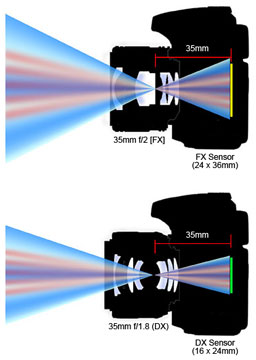I just saw this on another forum and thought it was a nice graphic to explain the difference between DX & FX crop factors.
OTHER FORUM USER said:Your D3100 is a DX camera, meaning it has a cropped sensor. A FX or full frame sensor is a lot larger so for instance a 50mm is exactly 50mm on a full frame sensor. On a cropped sensor camera, the sensor is smaller, so the field of view is a little different and makes a 50mm lens on a DX camera give you an equivalent of what a 75mm lens would look like on a 35mm full frame sensor body.
You could even use that 18-55 DX kit lens on a full frame camera too, but it will have vignetting.
Here's an idea of what I'm talking about.

Here's another

I don't know how much better I can explain it, but I hope this helps.
